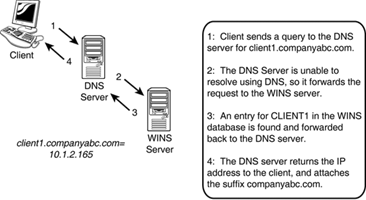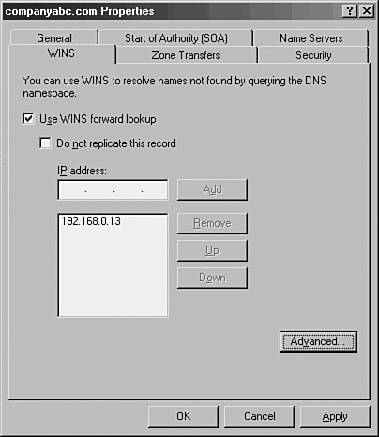Continuing Usage of Windows Internet Naming Service (WINS)
| The Windows Internet Naming Service (WINS) has a long history in Microsoft networks. Because early Microsoft networks were primarily broadcast-based using protocols such as NetBEUI to identify local computers, and there is a need to maintain backwards compatibility for earlier operating systems, Microsoft continues to support WINS. Legacy Microsoft NetBIOS ResolutionWINS is effectively a simple database of NetBIOS names and their corresponding IP addresses. Some additional information, such as domain name, server type, and so on, can be determined as well, from the 16th byte in a NetBIOS name stored in WINS. WINS is considered legacy in the Microsoft world because NetBIOS resolution is being phased out in favor of the domain name system (DNS) form of name resolution. However, it is difficult to divorce WINS from modern networks because of the reliance on WINS by down-level (pre-Windows 2000) clients , legacy applications, and even some Microsoft services such as DFS that use WINS by default. Consequently, you might need to keep using WINS in Windows networks, unless you can definitively prove that it is no longer necessary. Integrating WINS and DNSDNS can use the WINS database to provide for quasi-DNS resolution of WINS clients. This means that if a request is sent to a DNS server to resolve client1.companyabc.com , for example, it is possible for that DNS server to use the WINS database to resolve requests for any zones where the WINS forward lookup is configured. If Client1 does not exist in the DNS database but exists in the WINS database instead, the DNS server will return the IP address that it obtained from WINS and attach the companyabc.com suffix to the record, as illustrated in Figure 13.35. Figure 13.35. WINS integration with DNS. This functionality must be enabled on the DNS server because it is not configured by default. To enable WINS resolution on a DNS server, follow these steps:
Changes in Windows Server 2003 WINSAlthough =the overall function of WINS has not changed significantly in Windows Server 2003, some additions to the management tools allow for increased functionality and capabilities:
In addition to these advances in Windows Server 2003, Windows 2000 introduced enhancements to WINS, such as an updated database engine, persistent connections, manual tombstoning, and other improvements. |
EAN: 2147483647
Pages: 325

